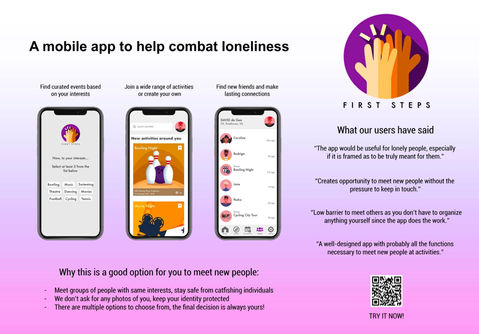Combating Loneliness through
UX Research & Design - First Steps
This case study details a design thinking project aimed at alleviating feelings of loneliness with the "First Steps" mobile application. The design process unfolded through the phases of empathizing, defining, ideating, prototyping, and testing, tailored for individuals who have recently relocated to new cities or countries.

Background
The COVID-19 pandemic precipitated a sharp rise in social isolation and loneliness, profoundly affecting individuals worldwide. Movement restrictions, social distancing measures, and lockdowns drastically limited opportunities for face-to-face interaction, exacerbating feelings of loneliness and isolation. Particularly for those moving abroad, already facing the challenges of adapting to a new environment, the pandemic further restricted their ability to establish social connections and support networks. Post-lockdown, reintroducing in-person interaction options became imperative, as virtual communication alone proved insufficient in combating the profound effects of prolonged physical separation. Reimagining ways to safely facilitate social interactions post-lockdowns became essential in addressing the heightened levels of loneliness and social isolation experienced by individuals worldwide.
Project Details
Individual Contribution
-
Timeline: September - November 2021
-
Team size: 5
-
Location: Eindhoven, The Netherlands
-
Research and analytics
-
Designing and prototyping
-
Visual elements and presentation
Design Methodologies
Technologies Used
-
Semi-structured user interviews
-
Thematic analysis using affinity diagrams
-
COCD box analysis
-
User personas and value scenarios
-
"Think-aloud" usability testing
-
Miro
-
Sketch
-
InVision
-
MS Office

Empathizing
Semi-structured interviews were conducted with individuals who recently moved to new locations, allowing for open-ended exploration of their emotional states, challenges, and coping mechanisms. The sampling strategy ensured diversity, capturing a range of perspectives across demographics, cultural backgrounds, and relocation circumstances. Thematic analysis of interview data revealed nuanced insights into the multifaceted nature of loneliness.
Defining
Affinity diagramming techniques were employed to organize and cluster interview responses, revealing common patterns and underlying issues. Through this process, five main themes emerged, including 'symptoms of loneliness,' 'barriers to overcome loneliness,' 'needs,' 'attitude towards solving loneliness,' and 'solutions.' These themes provided a comprehensive framework for understanding the target group's challenges and informed the design process.


Ideating
Divergent and convergent thinking techniques were utilized to generate and refine potential solutions. Brainstorming sessions were conducted to explore a wide range of ideas. Concepts such as a chat application for discussing common interests, a physical signaling device to connect with others feeling lonely, and a friend-finding platform akin to Tinder were generated. Through convergence, promising features and concepts were identified using methods like dot voting and COCD box analysis, guiding the selection of the final solution. Additionally, a value scenario was also created for ethical envisioning.
Designing
The design process integrated content and layout simultaneously to ensure coherence and minimize rework. Visual elements like icons, colors, and typography were prioritized for their impact on first impressions, with vector illustrations ensuring consistency. Design decisions prioritized user interactivity, such as multi-step forms during sign-up and explanatory notes for field importance. The dashboard layout provided an intuitive overview of user activities, aiming for seamless navigation to reduce cognitive load.


Prototyping
The high-fidelity prototype of the "First Steps" application was developed using Sketch and InVision, serving as a communication tool for collecting crucial feedback. The prototype was used to evaluate the overall concept, interactivity, and application functions, identifying challenging aspects. While compromises were made in detail, the prototype initially implemented all functions with less emphasis on specifics, gradually adding details based on importance. This iterative process ensured users experienced all functions, facilitating comprehensive feedback for refinement.
Testing
The prototype underwent usability tests using the think-aloud protocol to gather feedback on its functionalities, particularly considering the target group's mixed feelings towards traditional social apps. Tests included participants from previous empathizing stages and new participants to ensure representative feedback. Each test followed a structured format, including an introduction to loneliness, think-aloud explanation, and task completion. Participants provided feedback on design, navigation, and functionalities, with overall positive responses, though criticisms highlighted areas for improvement like clarifying descriptions and adding features such as event filtering and reminders. Feedback informed considerations for premium features, emphasizing the need for increased user autonomy and refinement of information presentation.
















